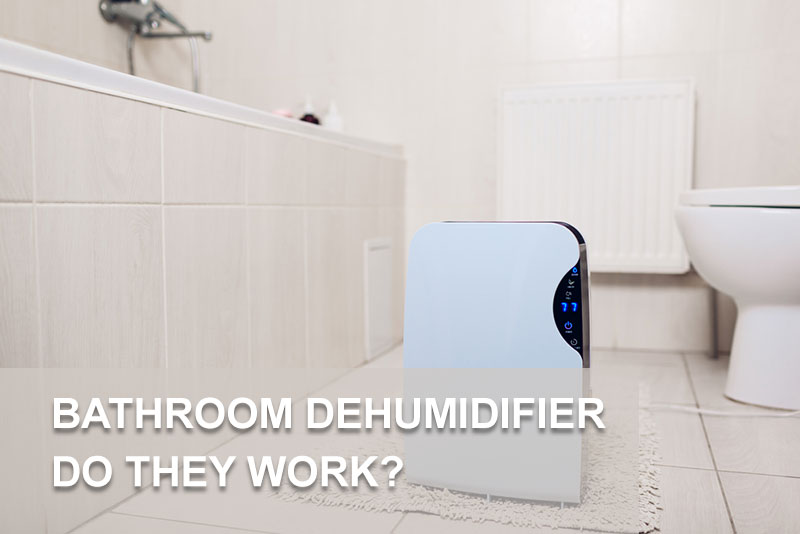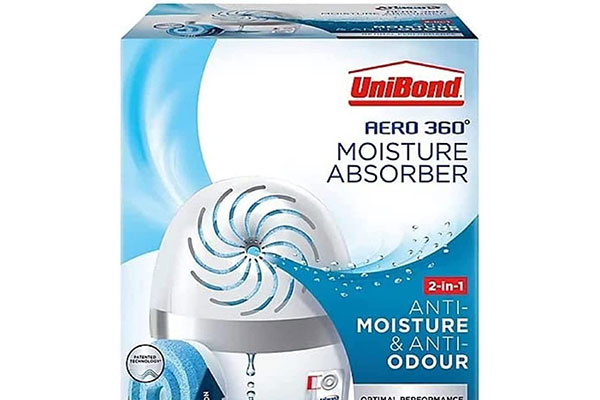Bathrooms are often the most damp prone room in our homes. If left unchecked, this can result in excess condensation and even mould growth. It’s important we deal with this problem and don’t let it get out of hand as no one wants a mouldy bathroom and smelly towels. This leaves us people asking ‘do dehumidifiers work in bathrooms?‘
Yes, dehumidifiers work in bathrooms and they work WELL. Dehumidifiers extract more water in warmer and more humid environments. Which room in your house is usually the warmest and most humid? Yes, that’s right, the bathroom. Dehumidifiers will extract significantly more water than usual from a bathroom and can be a great way to tackle excess humidity in the bathroom. It is best to combine a dehumidifier with other methods such as extractor fans and good ventilation. However, a dehumidifier will do a good job of dehumidifying a bathroom all on its own.

Pro Breeze 12L/Day Dehumidifier with Digital Humidity Display
Ideal for use in large rooms with persistent damp issues, continuous drainage hose is included, extracts up to 12L of moisture per day, LED display and touch panel with sleep and child lock, automatic humidity sensor (humidistat)
Should I Use a Bathroom Dehumidifier?
It is important to decide if you actually need a bathroom dehumidifier. There are some simple ways of answering this. First of all, does your bathroom suffer from excess humidity? If your bathroom shows signs of condensation long after use, or even mould growth, this is a telltale sign you could use a dehumidifier. Excess condensation will look like water on windowsills or droplets of water on walls long after use. Mould will typically look like patches of black dots often found in corners, on grout and walls.
If any of these describe your bathroom, you may want to get a bathroom dehumidifier. A dehumidifier is a quick and easy way of drying out a bathroom suffering from excess moisture and mould growth. They are well worth the investment as they can save you money on property damage and health damage from mould exposure. Once mould has been safely removed you can expect a dehumidifier to prevent resurgence.
What to Look for in a Bathroom Dehumidifier?
When looking for a bathroom dehumidifier, we recommend you look at our guide for the best UK dehumidifiers. We make some excellent recommendations, most of which would be suitable for bathroom use. To make it easier for you though, we recommend the Meaco ABC Range 10L Dehumidifier as our number 1 pick for bathroom use.

Meaco MeacoDry ABC Dehumidifier
10L – Ultra Quiet Dehumidifier – Energy Efficient Electric Compressor Dehumidifier
This is because it is a refrigerant type, very quiet, energy-efficient and offers great value. You can read our full review of the Meaco ABC Range 10L and 12L here.
Key Considerations for Bathroom Dehumidifiers:
Refridgerant vs Desiccant
To keep this simple, the two main types of dehumidifiers are refrigerant and desiccant. Desiccant dehumidifiers work better in colder environments whilst refrigerant dehumidifiers work better at higher temperatures. Bathrooms are generally warmer than other rooms, this makes the refrigerant type the most effective in the bathroom environment.
Cable length
Naturally, most bathrooms don’t have three-prong electric sockets in them so you need to carefully check that the dehumidifier you are looking at has a suitably long cable. We also don’t recommend using extension leads in bathrooms for safety purposes.
What Size Dehumidifier Do I Need for my Bathroom?

Meaco MeacoDry ABC Dehumidifier
10L – Ultra Quiet Dehumidifier – Energy Efficient Electric Compressor Dehumidifier
The average UK resident’s bathroom would be perfectly suited to any dehumidifier with a 6+ L/day extraction rate. Please don’t bother with mini-dehumidifiers as they are not powerful enough to make a meaningful difference in a bathroom. The Meaco ABC Range 12L we recommend would be more than adequate in size for almost any bathroom. Bigger is better here as bathrooms are particularly humid and warm, anything larger than 20L/day is probably overkill.
Other Ways to Dehumidify a Bathroom
Obviously, we don’t want you running out and buying a new appliance if it isn’t necessary. Please consider the following before buying:
Extractor Fan
An extractor fan is a great way of ventilating your bathroom and getting rid of the humidity generated by showers and other uses. If you don’t have one then you should consider getting one. Installation costs may vary however and is sometimes impossible. When installation costs are high, a dehumidifier may be a better option. You should also get a dehumidifier if an extractor fan alone isn’t working.
Ventilation
Leave windows and doors open when possible to better ventilate your bathroom. This can sometimes be problematic, especially in smaller flats. Oftentimes, leaving the door open may allow the moisture to escape into other parts of the house and cause condensation, this was a problem in my flat. Also, not all bathrooms have windows, in which case a dehumidifier may be the way to go.
Damp Towels
Leaving damp towels in the bathroom is another way of making the problem worse. Where possible, move them to a different area of the house to dry. Similarly to leaving the door open, however, this can increase the humidity in other parts of the house. A dehumidifier would keep the bathroom dry as well as helping to quickly dry towels.
Where to Place a Bathroom Dehumidifier?
This is an important question with potential safety implications. Firstly, you should place the dehumidifier in a location where it is less likely to be splashed, e.g. away from showers and sinks. Secondly, you will need to place it in an area where the cable will reach. This is why we recommend you check cable length before purchasing to be sure it will reach. Considering these two things, the best place is probably near the entrance of the bathroom.
Extractor Fan vs Bathroom Dehumidifier
Let’s take a quick look into the debate of extractor fan vs dehumidifier.
Cost – Dehumidifier. Extractor fans might be cheaper but will often cost more when installation costs are considered.
Convenience – Extractor Fan. Extractor fans are undeniably more convenient as they take up less space and are wired into the mains.
Energy Use – Extractor Fan. Extractor fans use less energy than dehumidifiers generally speaking. Energy-efficiency may differ however as performance must be considered.
Performance – Dehumidifier. A dehumidifier will without a doubt remove moisture quicker and more effectively than an extractor fan. This applies more so to larger capacity models such as 12L/day.
Space – Extractor Fan. An extractor fan is stored in the wall and takes up next to no space. A dehumidifier will take up precious bathroom floor space.
Functionality – Dehumidifier. A dehumidifier will have many more features such as a humidistat and timer. The dehumidifier will also assist in drying towels whereas the extractor fan won’t. Extractor fans generally only run whilst you are in the bathroom. This leaves your bathroom vulnerable to dampness when you leave the room after a shower.
The Verdict – It Depends.
If you are able to install an extractor fan, you should do so. If you still have moisture issues, or cannot install an extractor fan, look into getting a dehumidifier.
Final Thought
Many people have damp bathrooms suffering from excess humidity. The dehumidifier often isn’t thought of as a bathroom appliance but this shouldn’t be the case. A dehumidifier can play a big role in eliminating damp in the bathroom. There are alternatives such as extractor fans but oftentimes these aren’t enough to totally fix the problem. It is also interesting to note that bathroom dehumidifiers can assist with drying our towels. We hope this article has helped you understand how dehumidifiers work in bathrooms.
Last update on 2025-02-28 / Affiliate links / Images from Amazon Product Advertising API







